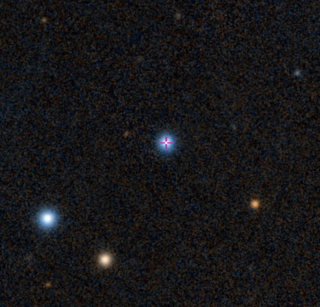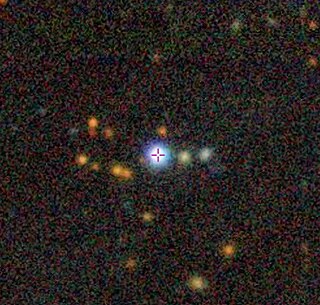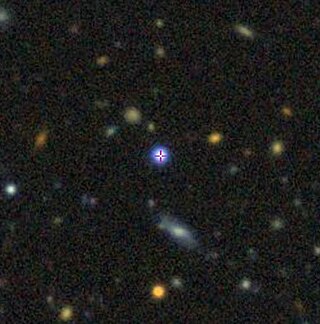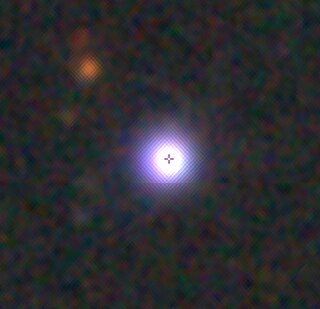
A quasar is an extremely luminous active galactic nucleus (AGN). It is sometimes known as a quasi-stellar object, abbreviated QSO. The emission from an AGN is powered by a supermassive black hole with a mass ranging from millions to tens of billions of solar masses, surrounded by a gaseous accretion disc. Gas in the disc falling towards the black hole heats up and releases energy in the form of electromagnetic radiation. The radiant energy of quasars is enormous; the most powerful quasars have luminosities thousands of times greater than that of a galaxy such as the Milky Way. Quasars are usually categorized as a subclass of the more general category of AGN. The redshifts of quasars are of cosmological origin.
An active galactic nucleus (AGN) is a compact region at the center of a galaxy that emits a significant amount of energy across the electromagnetic spectrum, with characteristics indicating that this luminosity is not produced by the stars. Such excess, non-stellar emissions have been observed in the radio, microwave, infrared, optical, ultra-violet, X-ray and gamma ray wavebands. A galaxy hosting an AGN is called an active galaxy. The non-stellar radiation from an AGN is theorized to result from the accretion of matter by a supermassive black hole at the center of its host galaxy.

A supermassive black hole is the largest type of black hole, with its mass being on the order of hundreds of thousands, or millions to billions, of times the mass of the Sun (M☉). Black holes are a class of astronomical objects that have undergone gravitational collapse, leaving behind spheroidal regions of space from which nothing can escape, including light. Observational evidence indicates that almost every large galaxy has a supermassive black hole at its center. For example, the Milky Way galaxy has a supermassive black hole at its center, corresponding to the radio source Sagittarius A*. Accretion of interstellar gas onto supermassive black holes is the process responsible for powering active galactic nuclei (AGNs) and quasars.

A blazar is an active galactic nucleus (AGN) with a relativistic jet directed very nearly towards an observer. Relativistic beaming of electromagnetic radiation from the jet makes blazars appear much brighter than they would be if the jet were pointed in a direction away from Earth. Blazars are powerful sources of emission across the electromagnetic spectrum and are observed to be sources of high-energy gamma ray photons. Blazars are highly variable sources, often undergoing rapid and dramatic fluctuations in brightness on short timescales. Some blazar jets appear to exhibit superluminal motion, another consequence of material in the jet traveling toward the observer at nearly the speed of light.

III Zw 2 is a Seyfert 1 galaxy located in the Pisces constellation. It has a redshift of 0.089 and is notable as the first of its kind to exhibit a superluminal jet.

3C 345 is a blazar/flat spectrum radio quasar located in the constellation of Hercules. It is noted for hosting a superluminal jet and its variability in almost all wave bands.

4C +71.07 known as S5 0836+71, is a quasar located in the constellation Ursa Major. Based on its high redshift, the object is located 10.7 billion light-years away from Earth and such, classified as a blazar with a flat-spectrum radio source and features a radio jet.

PKS 0537-286, also known as QSO B0537-286, is a quasar located in the constellation Columba. With a redshift of 3.104, the object is located 11.4 billion light years away and belongs to the flat spectrum radio quasar blazar subclass (FSQR). It is one of the most luminous known high-redshift quasars.

PKS 0438-436, also known as PKS J0440-4333, is a quasar located in constellation Caelum. With a high redshift of 2.86, the object is located 11.2 billion light-years from Earth and is classified as a blazar due to its flat-spectrum radio source, (in terms of the flux density as with α < 0.5 and its optical polarization.

PKS 2215+020, known as PMN J2217+0220, is a quasar located in the Aquarius constellation. Its redshift is 3.570000, meaning the object is located 11.6 billion light-years away from Earth. It is classified as a flat spectrum radio source quasar.

PKS 2126-158, also known as PKS 2126-15, is a quasar located in Capricornus. It has a redshift of 3.268000, which corresponds to the distance of 11.5 billion light years. It is classified as a gigahertz peaked-spectrum quasar (GPS) with a flat-spectrum radio source and a blazar, a type of active galaxy shooting an astrophysical jet towards Earth.

QSO J0100-2708 is a quasar located in the constellation Sculptor. With a redshift of 3.520000, the object is located 11.5 billion light-years away from Earth and contains a flat-spectrum radio source found brighter compared to S4.8 GHz=65 mJy.

PKS 0226-559 known as PMN J0228-5546 is a quasar located in the constellation Horologium. At the redshift of 2.464, the object is roughly 10.6 billion light-years from Earth.

PKS 0451-28, also known as MRC 0451-282, is a quasar located in the constellation of Caelum. Its redshift is 2.55, estimating the object to be located nearly 10.8 billion light-years away from Earth.

PKS 1144-379 also known as PKS B1144-379, is a quasar located in the constellation of Centaurus. At the redshift of 1.048, the object is located nearly 8 billion light-years from Earth.

PKS 1402-012, also known as UM 632, is a quasar located in the constellation of Virgo. With a redshift of 2.51, the object is located 10.7 billion light-years from Earth.

PKS 1402+044 is a quasar located in the constellation of Virgo. It has a redshift of 3.207, estimating the object to be located 11.3 billion light-years away from Earth.

PKS 0805-07 also known as PMN J0808-0751 and 4FGL J0808.2-0751, is a quasar located in the constellation of Monoceros. With a redshift of 1.83, light has taken at least 10 billion light-years to reach Earth.



















